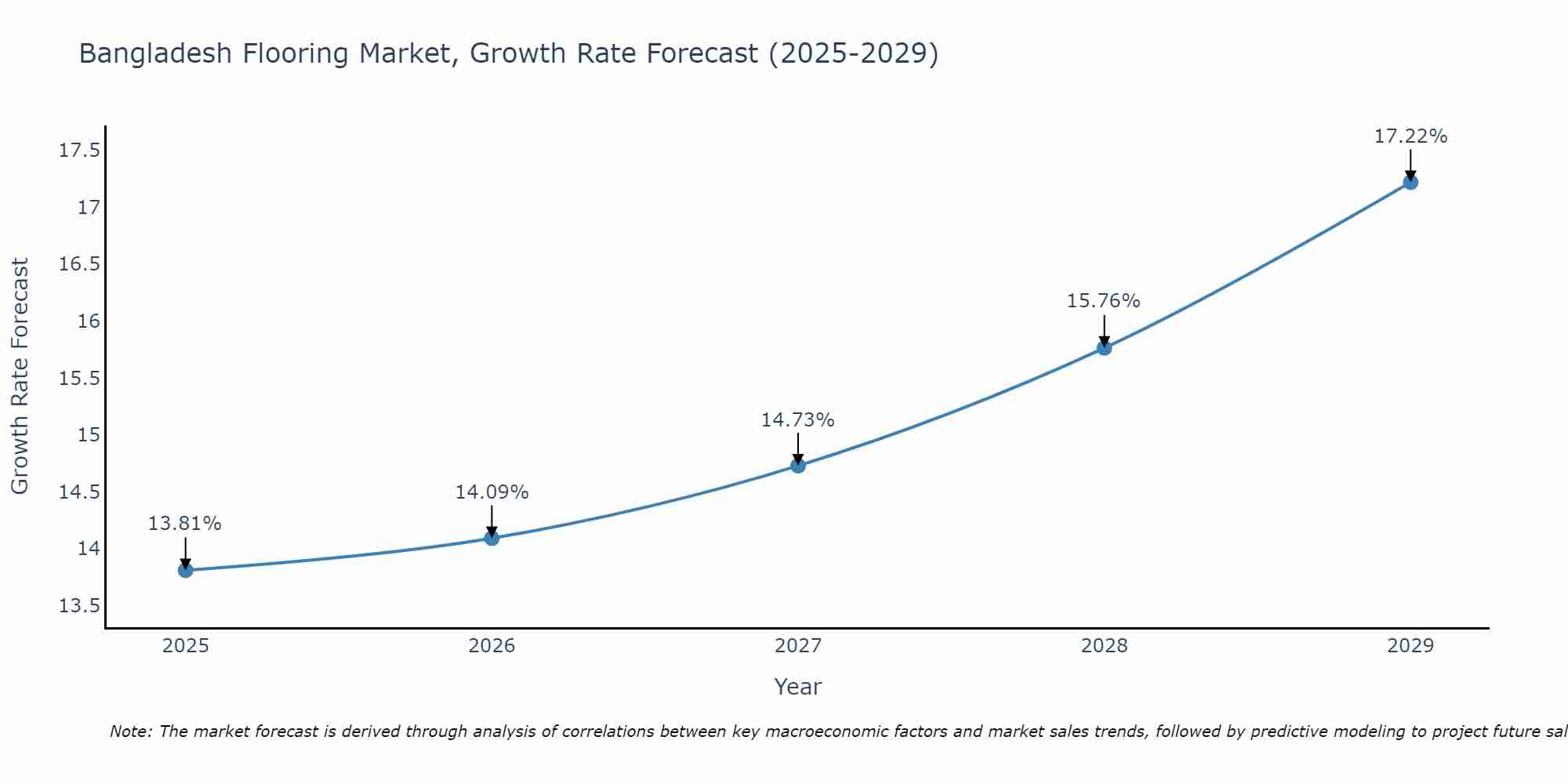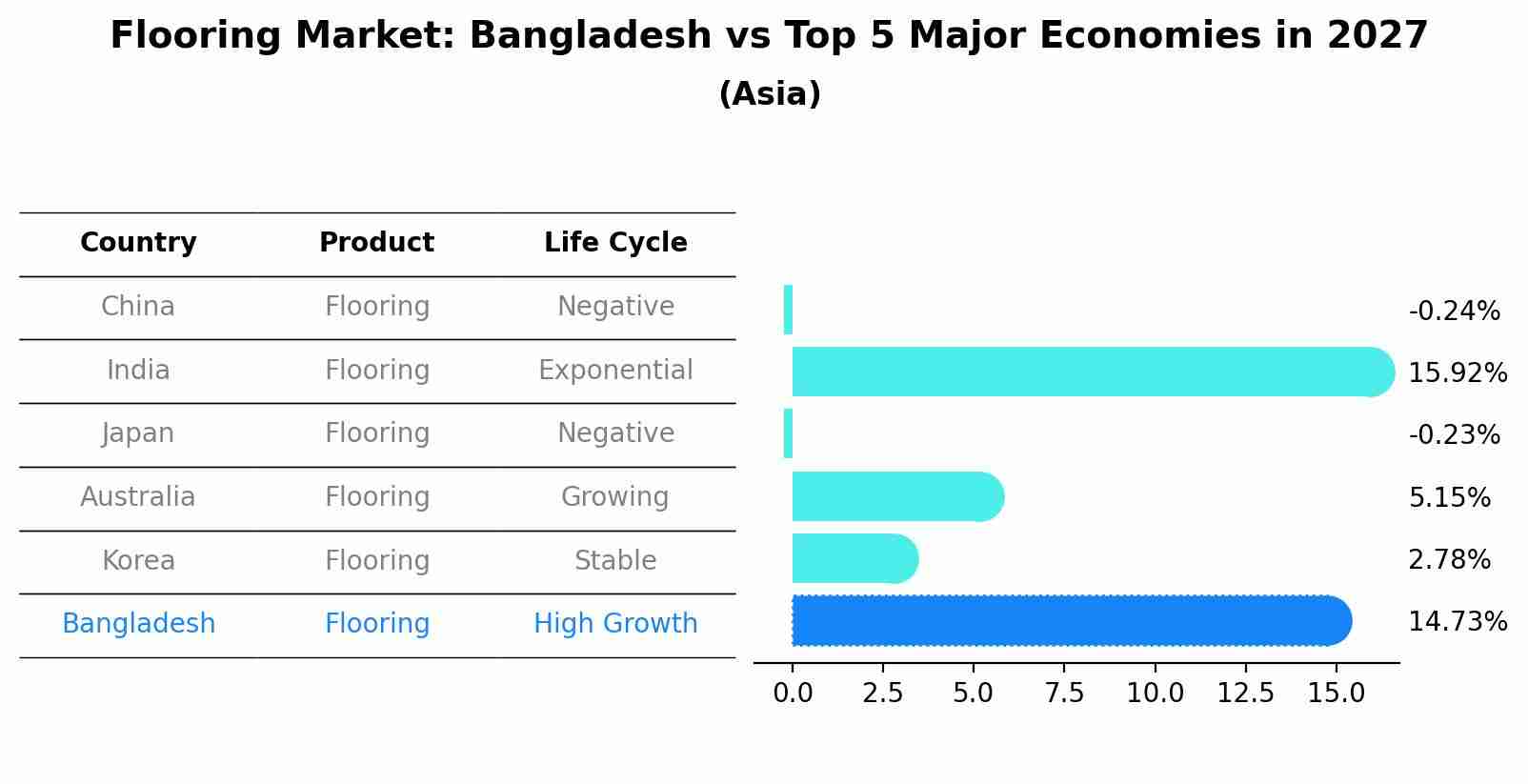Bangladesh Flooring Market (2025-2031) | Size, Value, Growth, Forecast, Outlook, Revenue, Industry, Trends, Analysis, Share & Companies
| Product Code: ETC010792 | Publication Date: Oct 2020 | Updated Date: Jun 2025 | Product Type: Report | |
| Publisher: 6Wresearch | Author: Ravi Bhandari | No. of Pages: 70 | No. of Figures: 35 | No. of Tables: 5 |
Bangladesh Flooring Market Size Growth Rate
The Bangladesh Flooring Market is likely to experience consistent growth rate gains over the period 2025 to 2029. The growth rate starts at 13.81% in 2025 and reaches 17.22% by 2029.

Flooring Market: Bangladesh vs Top 5 Major Economies in 2027 (Asia)
Bangladesh's Flooring market is anticipated to experience a high growth rate of 14.73% by 2027, reflecting trends observed in the largest economy China, followed by India, Japan, Australia and South Korea.

Bangladesh Flooring Market Overview
The Bangladesh flooring market is experiencing steady growth driven by factors such as rapid urbanization, increasing disposable income, and a growing focus on interior design aesthetics. The market offers a wide range of flooring options including tiles, marble, laminate, vinyl, and hardwood, catering to both residential and commercial sectors. The demand for durable, easy-to-maintain flooring solutions is on the rise, leading to a shift towards modern and innovative products. Key players in the market are introducing eco-friendly and cost-effective flooring materials to meet the evolving consumer preferences. Additionally, government initiatives promoting infrastructure development and construction activities are expected to further boost the demand for flooring products in Bangladesh.
Bangladesh Flooring Market Trends
The Bangladesh flooring market is experiencing a shift towards sustainable and eco-friendly flooring materials such as bamboo, cork, and recycled materials. Consumers are increasingly looking for flooring options that are not only aesthetically pleasing but also environmentally conscious. Additionally, there is a growing demand for innovative and customizable flooring solutions that allow for personalization and creativity in interior design. Luxury vinyl tiles (LVT) and laminate flooring are also gaining popularity due to their durability, ease of maintenance, and cost-effectiveness. With the rise in urbanization and construction activities in Bangladesh, the flooring market is expected to continue growing, driven by the increasing focus on quality, design versatility, and sustainability in flooring products.
Bangladesh Flooring Market Challenges
In the Bangladesh Flooring Market, there are several challenges that hinder growth and development. One major challenge is the dominance of traditional flooring materials such as ceramic tiles and marble, which makes it difficult for newer, innovative flooring options to gain traction. Additionally, the lack of awareness and education among consumers about the benefits of modern flooring solutions like laminate, vinyl, and engineered wood poses a challenge for market penetration. Limited availability of high-quality raw materials locally, coupled with fluctuating prices of imported materials, also impact the cost and accessibility of flooring products in the market. Furthermore, inadequate infrastructure and skilled labor in the installation and maintenance of specialized flooring products contribute to the challenges faced by the Bangladesh Flooring Market.
Bangladesh Flooring Market Investment Opportunities
The Bangladesh Flooring Market presents promising investment opportunities due to the country`s growing construction and real estate sectors. With rapid urbanization and increasing disposable income, there is a rising demand for high-quality and aesthetically pleasing flooring solutions in residential, commercial, and industrial spaces. Investors can explore opportunities in providing innovative and sustainable flooring materials such as laminate, vinyl, hardwood, and tiles to cater to the diverse needs of the market. Additionally, the adoption of modern construction practices and the emphasis on interior design aesthetics offer avenues for investment in specialized flooring services and solutions. Collaborating with local manufacturers, distributors, and construction firms can help investors capitalize on the expanding market potential in Bangladesh`s flooring sector.
Bangladesh Flooring Market Government Policy
The government policies related to the Bangladesh flooring market primarily focus on promoting sustainable and environmentally friendly practices. The government has implemented regulations to ensure that flooring materials meet safety and quality standards, with a particular emphasis on reducing the use of harmful chemicals and promoting eco-friendly options. Additionally, there are incentives and subsidies available to encourage the adoption of renewable materials and energy-efficient flooring solutions. The government also supports initiatives to boost the domestic production of flooring materials, aiming to reduce reliance on imports and stimulate economic growth in the sector. Overall, the government`s policies in the Bangladesh flooring market align with global trends towards sustainability and responsible resource management.
Bangladesh Flooring Market Future Outlook
The Bangladesh flooring market is poised for steady growth in the coming years due to rapid urbanization, increasing disposable income, and a booming construction industry. The demand for high-quality and aesthetically pleasing flooring solutions is on the rise, driven by a growing middle-class population seeking modern and durable flooring options for residential and commercial spaces. Additionally, the government`s focus on infrastructure development and sustainable construction practices will further fuel the demand for innovative flooring materials. Key trends shaping the future of the Bangladesh flooring market include the adoption of eco-friendly and low-maintenance flooring options, such as laminate, vinyl, and engineered wood. Overall, the market is expected to witness robust growth as consumers prioritize aesthetics, functionality, and sustainability in their flooring choices.
Key Highlights of the Report:
- Bangladesh Flooring Market Outlook
- Market Size of Bangladesh Flooring Market, 2024
- Forecast of Bangladesh Flooring Market, 2026
- Historical Data and Forecast of Bangladesh Flooring Revenues & Volume for the Period 2021 - 2031
- Bangladesh Flooring Market Trend Evolution
- Bangladesh Flooring Market Drivers and Challenges
- Bangladesh Flooring Price Trends
- Bangladesh Flooring Porter's Five Forces
- Bangladesh Flooring Industry Life Cycle
- Historical Data and Forecast of Bangladesh Flooring Market Revenues & Volume By Product Type for the Period 2021 - 2031
- Historical Data and Forecast of Bangladesh Flooring Market Revenues & Volume By Soft Coverings for the Period 2021 - 2031
- Historical Data and Forecast of Bangladesh Flooring Market Revenues & Volume By Resilient Flooring for the Period 2021 - 2031
- Historical Data and Forecast of Bangladesh Flooring Market Revenues & Volume By Non-Resilient Flooring for the Period 2021 - 2031
- Historical Data and Forecast of Bangladesh Flooring Market Revenues & Volume By Seamless Flooring for the Period 2021 - 2031
- Historical Data and Forecast of Bangladesh Flooring Market Revenues & Volume By Applications for the Period 2021 - 2031
- Historical Data and Forecast of Bangladesh Flooring Market Revenues & Volume By Residential for the Period 2021 - 2031
- Historical Data and Forecast of Bangladesh Flooring Market Revenues & Volume By Commercial for the Period 2021 - 2031
- Historical Data and Forecast of Bangladesh Flooring Market Revenues & Volume By Industrial for the Period 2021 - 2031
- Bangladesh Flooring Import Export Trade Statistics
- Market Opportunity Assessment By Product Type
- Market Opportunity Assessment By Applications
- Bangladesh Flooring Top Companies Market Share
- Bangladesh Flooring Competitive Benchmarking By Technical and Operational Parameters
- Bangladesh Flooring Company Profiles
- Bangladesh Flooring Key Strategic Recommendations
Frequently Asked Questions About the Market Study (FAQs):
1 Executive Summary |
2 Introduction |
2.1 Key Highlights of the Report |
2.2 Report Description |
2.3 Market Scope & Segmentation |
2.4 Research Methodology |
2.5 Assumptions |
3 Bangladesh Flooring Market Overview |
3.1 Bangladesh Country Macro Economic Indicators |
3.2 Bangladesh Flooring Market Revenues & Volume, 2019 & 2026F |
3.3 Bangladesh Flooring Market - Industry Life Cycle |
3.4 Bangladesh Flooring Market - Porter's Five Forces |
3.5 Bangladesh Flooring Market Revenues & Volume Share, By Product Type, 2019 & 2026F |
3.6 Bangladesh Flooring Market Revenues & Volume Share, By Applications, 2019 & 2026F |
4 Bangladesh Flooring Market Dynamics |
4.1 Impact Analysis |
4.2 Market Drivers |
4.3 Market Restraints |
5 Bangladesh Flooring Market Trends |
6 Bangladesh Flooring Market, By Types |
6.1 Bangladesh Flooring Market, By Product Type |
6.1.1 Overview and Analysis |
6.1.2 Bangladesh Flooring Market Revenues & Volume, By Product Type, 2016 - 2026F |
6.1.3 Bangladesh Flooring Market Revenues & Volume, By Soft Coverings, 2016 - 2026F |
6.1.4 Bangladesh Flooring Market Revenues & Volume, By Resilient Flooring, 2016 - 2026F |
6.1.5 Bangladesh Flooring Market Revenues & Volume, By Non-Resilient Flooring, 2016 - 2026F |
6.1.6 Bangladesh Flooring Market Revenues & Volume, By Seamless Flooring, 2016 - 2026F |
6.2 Bangladesh Flooring Market, By Applications |
6.2.1 Overview and Analysis |
6.2.2 Bangladesh Flooring Market Revenues & Volume, By Residential, 2016 - 2026F |
6.2.3 Bangladesh Flooring Market Revenues & Volume, By Commercial, 2016 - 2026F |
6.2.4 Bangladesh Flooring Market Revenues & Volume, By Industrial, 2016 - 2026F |
7 Bangladesh Flooring Market Import-Export Trade Statistics |
7.1 Bangladesh Flooring Market Export to Major Countries |
7.2 Bangladesh Flooring Market Imports from Major Countries |
8 Bangladesh Flooring Market Key Performance Indicators |
9 Bangladesh Flooring Market - Opportunity Assessment |
9.1 Bangladesh Flooring Market Opportunity Assessment, By Product Type, 2019 & 2026F |
9.2 Bangladesh Flooring Market Opportunity Assessment, By Applications, 2019 & 2026F |
10 Bangladesh Flooring Market - Competitive Landscape |
10.1 Bangladesh Flooring Market Revenue Share, By Companies, 2024 |
10.2 Bangladesh Flooring Market Competitive Benchmarking, By Operating and Technical Parameters |
11 Company Profiles |
12 Recommendations |
13 Disclaimer |
- Single User License$ 1,995
- Department License$ 2,400
- Site License$ 3,120
- Global License$ 3,795
Search
Thought Leadership and Analyst Meet
Our Clients
Related Reports
- Germany Breakfast Food Market (2026-2032) | Industry, Share, Growth, Size, Companies, Value, Analysis, Revenue, Trends, Forecast & Outlook
- Australia Briquette Market (2025-2031) | Growth, Size, Revenue, Forecast, Analysis, Trends, Value, Share, Industry & Companies
- Vietnam System Integrator Market (2025-2031) | Size, Companies, Analysis, Industry, Value, Forecast, Growth, Trends, Revenue & Share
- ASEAN and Thailand Brain Health Supplements Market (2025-2031) | Strategy, Consumer Insights, Analysis, Investment Trends, Opportunities, Growth, Size, Share, Industry, Revenue, Segments, Value, Segmentation, Supply, Forecast, Restraints, Outlook, Competition, Drivers, Trends, Demand, Pricing Analysis, Competitive, Strategic Insights, Companies, Challenges
- ASEAN Bearings Market (2025-2031) | Strategy, Consumer Insights, Analysis, Investment Trends, Opportunities, Growth, Size, Share, Industry, Revenue, Segments, Value, Segmentation, Supply, Forecast, Restraints, Outlook, Competition, Drivers, Trends, Demand, Pricing Analysis, Competitive, Strategic Insights, Companies, Challenges
- Europe Flooring Market (2025-2031) | Outlook, Share, Industry, Trends, Forecast, Companies, Revenue, Size, Analysis, Growth & Value
- Saudi Arabia Manlift Market (2025-2031) | Outlook, Size, Growth, Trends, Companies, Industry, Revenue, Value, Share, Forecast & Analysis
- Uganda Excavator, Crane, and Wheel Loaders Market (2025-2031) | Strategy, Consumer Insights, Analysis, Investment Trends, Opportunities, Growth, Size, Share, Industry, Revenue, Segments, Value, Segmentation, Supply, Forecast, Restraints, Outlook, Competition, Drivers, Trends, Demand, Pricing Analysis, Competitive, Strategic Insights, Companies, Challenges
- Rwanda Excavator, Crane, and Wheel Loaders Market (2025-2031) | Strategy, Consumer Insights, Analysis, Investment Trends, Opportunities, Growth, Size, Share, Industry, Revenue, Segments, Value, Segmentation, Supply, Forecast, Restraints, Outlook, Competition, Drivers, Trends, Demand, Pricing Analysis, Competitive, Strategic Insights, Companies, Challenges
- Kenya Excavator, Crane, and Wheel Loaders Market (2025-2031) | Strategy, Consumer Insights, Analysis, Investment Trends, Opportunities, Growth, Size, Share, Industry, Revenue, Segments, Value, Segmentation, Supply, Forecast, Restraints, Outlook, Competition, Drivers, Trends, Demand, Pricing Analysis, Competitive, Strategic Insights, Companies, Challenges
Industry Events and Analyst Meet
Whitepaper
- Middle East & Africa Commercial Security Market Click here to view more.
- Middle East & Africa Fire Safety Systems & Equipment Market Click here to view more.
- GCC Drone Market Click here to view more.
- Middle East Lighting Fixture Market Click here to view more.
- GCC Physical & Perimeter Security Market Click here to view more.
6WResearch In News
- Doha a strategic location for EV manufacturing hub: IPA Qatar
- Demand for luxury TVs surging in the GCC, says Samsung
- Empowering Growth: The Thriving Journey of Bangladesh’s Cable Industry
- Demand for luxury TVs surging in the GCC, says Samsung
- Video call with a traditional healer? Once unthinkable, it’s now common in South Africa
- Intelligent Buildings To Smooth GCC’s Path To Net Zero


















